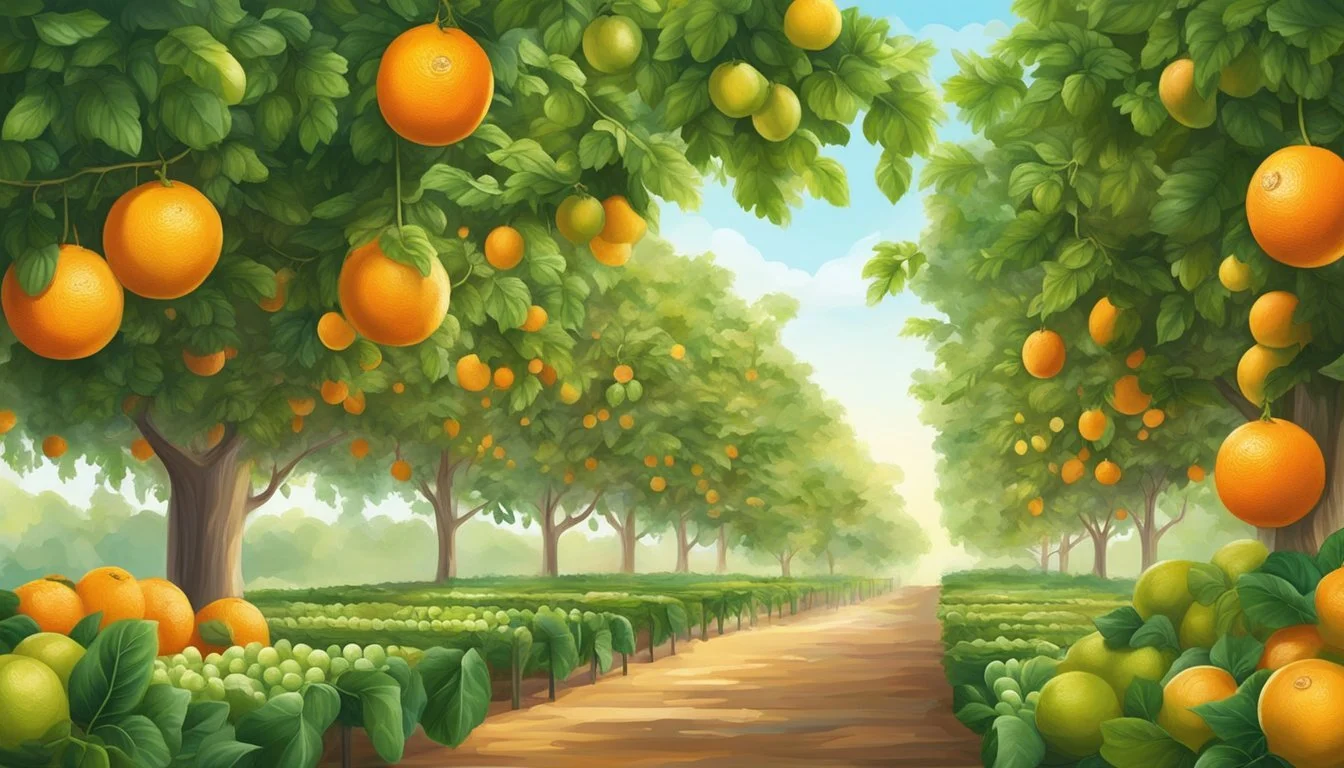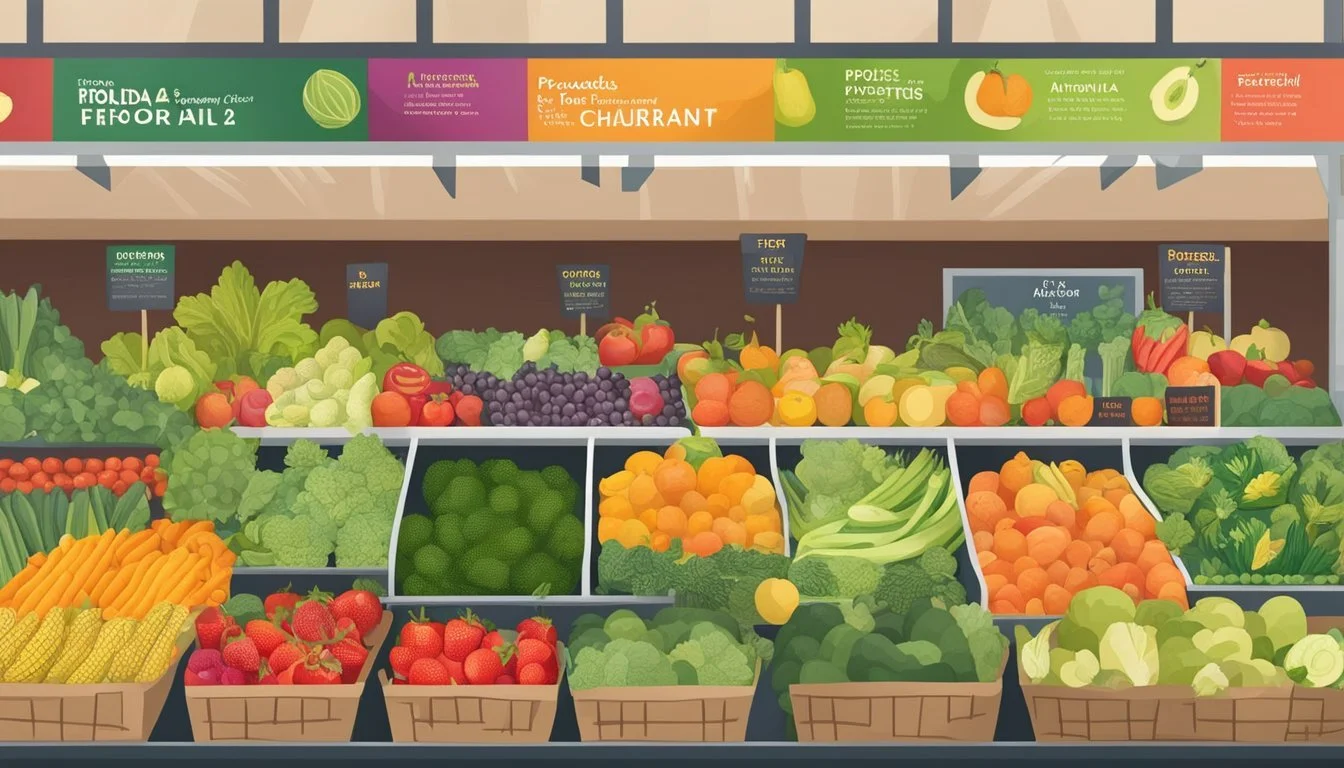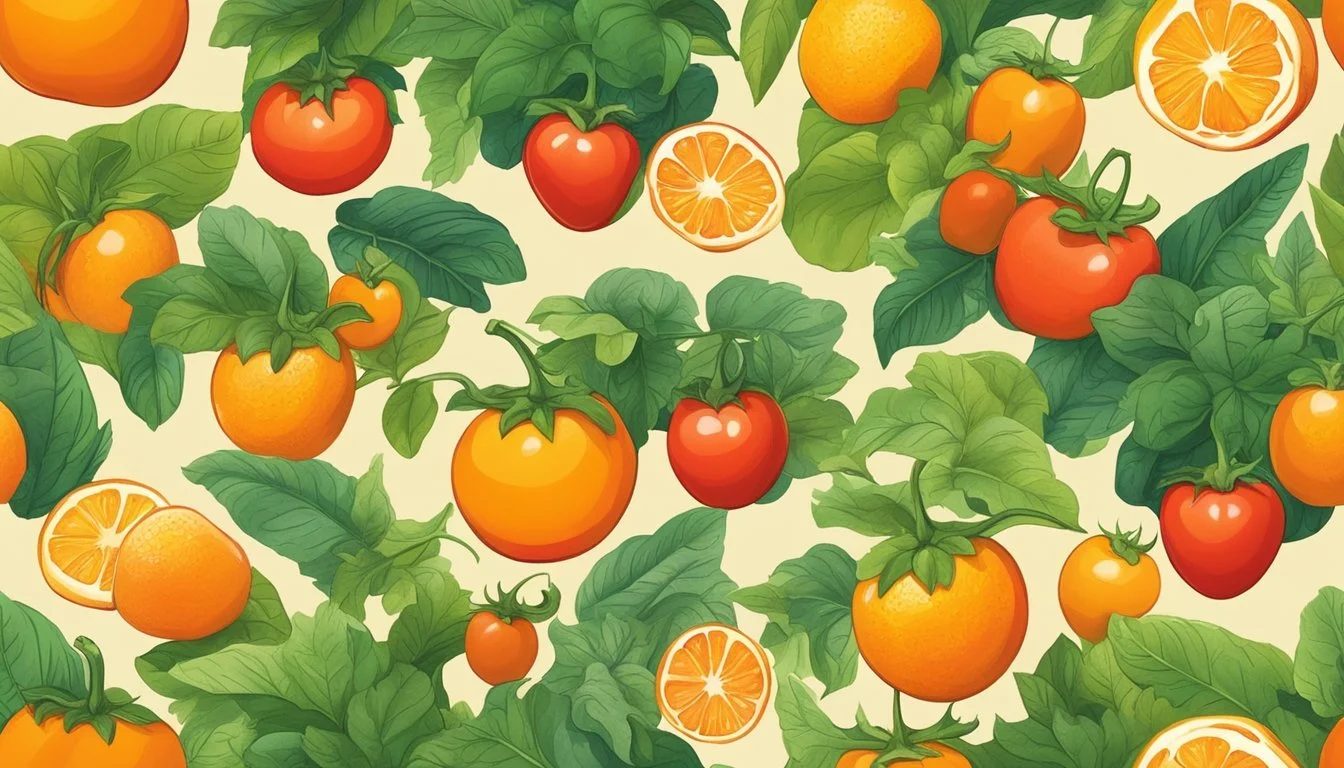Florida Seasonal Fruit & Vegetables in February
Your Guide to Fresh Produce
This Article is Part of our Florida Seasonal Fruit & Veg Calendar
Florida's rich, sun-drenched lands offer a diverse tapestry of fruits and vegetables that shift with the seasons. February marks a month where, amid mild temperatures, a variety of produce reaches peak ripeness. With the advantage of a subtropical climate, Florida provides a bounty of both temperate and tropical produce unlike any other state. Consumers have the opportunity to enjoy fresh, local flavors that are both nutritious and more flavorful due to reduced transit time from farm to table.
The selection of vegetables available from Floridian soil in February is vibrant and ample. In the cool of winter, leafy greens thrive, bringing forth robust harvests of kale and collard greens (how long do collard greens last?). Root vegetables such as radishes and beetroots also offer their earthy delights. These crops benefit from the cooler weather, which often enhances their natural sugars and textures.
Fruit-wise, citrus fruits are the stars of the season in Florida, perfuming the air with a zesty fragrance. February is an excellent time for harvesting grapefruits, oranges, and tangerines. Trees laden with fruit signify the height of citrus season, boasting a freshness and juiciness that supermarket imports often lack. Berry lovers are also in for a treat as strawberries are in full swing, dotting fields with their juicy red splendor, ready to be plucked and savored.
Overview of Florida's Seasonal Produce
Florida's climate grants it a unique advantage in growing a wide range of fresh fruits and vegetables, many of which reach peak season during the winter months. The state experiences a subtropical to tropical climate that allows for an extensive growing season, encompassing the cool and mild winter period. The Florida Department of Agriculture and Consumer Services recognizes the importance of supporting local produce, ensuring that consumables are fresh and of high quality.
Winter in Florida is synonymous with the height of citrus season. Groves brim with grapefruits, oranges, and tangerines. These citrus fruits, alongside strawberries and carambola, are renowned for their vibrant flavors and freshness during February.
Vegetables also thrive during this season. Farmers harvest cool-weather crops such as broccoli (how long does broccoli last?), collard greens, and lettuce—these leafy greens are hearty and nutritious. Other vegetables like peppers, tomatoes, and potatoes are also widely available, thanks to Florida's favorable conditions for these crops during the winter.
The list below highlights prominent fruits and vegetables available in Florida during the month of February:
Fruits:
Grapefruit
Oranges
Tangerines
Strawberries
Carambola (star fruit)
Guava
Vegetables:
Broccoli
Collard Greens
Lettuce
Peppers
Tomatoes
Potatoes
Cabbage
Consumers seeking the freshest local produce are encouraged to look for the "Fresh from Florida" label, a testament to the produce meeting the high standards set by the state's agricultural authorities.
Citrus Fruits in Season
Florida’s February climate offers ideal conditions for harvesting citrus fruits, providing an abundance of flavors and health benefits, particularly in vitamin C content.
Grapefruit Varieties
In February, Florida witnesses the peak season for grapefruit, including the Ruby Red, characterized by its vibrant blush and sweet-tart flavor, and the Flame Grapefruit, with a deeper red hue and a sweeter taste. These grapefruits are commonly enjoyed fresh or utilized for their zest in culinary dishes.
Ruby Red: Sweet-tart, vibrant blush
Flame Grapefruit: Sweeter taste, deep red color
Oranges and Tangerines
This month is also perfect for oranges and tangerines. The Valencia oranges, known for their juice, are widely available. The tangerine, a smaller cousin to oranges and equally rich in vitamin C, is also in season. Tangerines are favored for their less acidic taste and easier peeling.
Valencia Oranges: Excellent for juice, sweet flavor
Tangerines: Less acidic, easy to peel
Other Citrus Delights
Beyond grapefruit, oranges, and tangerines, Florida's citrus bounty includes varieties like tangelos, a tangerine-grapefruit hybrid with a juicy burst and a high vitamin C quotient, making it a February favorite. These citrus options offer diverse uses from fresh eating to adding zest to recipes.
Tangelos: Juicy, high in vitamin C
Vegetables Available in February
In February, Florida's unique climate allows for the cultivation of a variety of vegetables. Gardeners and consumers can enjoy fresh produce that includes root vegetables, leafy greens, and cruciferous vegetables.
Root Vegetables
Potatoes: A staple root vegetable, potatoes are versatile for cooking and are harvested in Florida during this month.
Carrots: Known for their sweetness and crunch, carrots thrive in February's cooler temperatures.
Radishes: Offering a peppery bite, radishes are quick to mature and ready for harvest.
Celery Root: Also known as celeriac, this knobby root is prized for its distinctive flavor.
Leafy Greens
Leafy Greens
Kale: Rich in nutrients, kale is hearty and grows well in the mild winter.
Collard Greens: A traditional southern green, collards are tolerant of cooler temperatures and can be harvested now.
Lettuce: Various types of lettuce, including romaine and leaf lettuce, are in season, perfect for fresh salads.
Cruciferous Vegetables
Cruciferous Vegetables
Broccoli: This green vegetable, rich in vitamins, is ready for picking in February.
Cabbage: Cabbage, both green and red, is crisp and sweet when grown in the cool month.
Cauliflower: With its tight, white florets, cauliflower enjoys the cooler weather of Florida's winter.
Berry Season Peak
In Florida, February marks a critical month for berry crops, with strawberries seeing a peak in harvest availability.
Strawberries Spotlight
The strawberry harvest in Florida begins to intensify in February, providing consumers with some of the freshest and most flavorful berries. Strawberries, grown primarily in the central and southern regions of the state, require a delicate balance of cool nights and warm days to flourish.
Harvest Dates: Typically starts in early April
Peak Season: February through April
Growing Regions: Central and Southern Florida
Consumers should look for strawberries that are bright red, firm to the touch, and have a fragrant aroma, which are indicators of peak ripeness and flavor. During this period, strawberries are widely available at local markets, U-pick farms, and grocery stores throughout the state.
Tropical Fruits and Off-Season Varieties
February in Florida offers a unique range of tropical fruits that are not typically in season in other areas of the United States during this time. Two main highlights of this month’s produce are avocados and papayas, as well as guava and carambola, with each bringing its distinct taste and nutritional benefits to the table.
Avocados and Papayas
Avocados in Florida vary in size and type, but they remain a nutritious source of healthy fats and vitamins in February. Papayas, on the other hand, are often at the peak of their sweetness. They provide a rich source of vitamin C and other antioxidants, making them not just flavorful but also a healthful choice.
Fruit Availability Nutritional Benefit Avocados Available Healthy fats, Vitamins K, E, and C Papayas Peak Season Vitamin C, Antioxidants, Digestive Enzymes
Guava and Carambola
Guava is a fruit that Floridians can enjoy in February, recognized for its intense fragrance and flavor, packed with vitamins A and C. Carambola, or star fruit, is another tropical produce that can be found readily throughout the month. It's known not only for its distinct star shape when sliced but also for its crisp texture and sweet and sour flavor profile.
Fruit Availability Nutritional Benefit Guava In Season Vitamins A and C, Fiber Carambola Available, Weather Dependent Vitamin C, Antioxidants
These fruits are especially valued for their year-round availability in Florida, providing an off-season source of freshness and nutrition.
Cooking and Recipe Ideas
In February, Florida's seasonal produce affords an abundance of opportunities for vibrant salads, comforting stews, and refreshing snacks. The recipes capitalize on the peak freshness of ingredients.
Salads and Side Dishes
Citrus Fruit Salad: A simple mix of grapefruit, oranges, and tangerines can be tossed with a honey vinaigrette for a refreshing salad.
Roasted Root Vegetables: Carrots and turnips can be sliced, seasoned, and roasted for a hearty side dish to any family meal.
Sweets and Snacks
Smoothies: Blend Florida's produce like strawberries and citrus fruits for a nutritious family-friendly snack.
Fruit Wraps: Spread almond butter on whole-grain tortillas and wrap them around slices of apples or bananas for a quick snack.
Soups and Stews
Vegetable Stew: Utilize a variety of in-season vegetables like broccoli and leafy greens to create a warming stew, enhanced with herbs and spices for deep flavor.
Cream of Broccoli Soup: Transform broccoli into a creamy soup, perfect for chilly evenings, garnished with sharp cheddar cheese.
By integrating these seasonal fruits and vegetables into these recipe suggestions, cooks can take advantage of the freshest local produce while preparing delicious meals and snacks.
Where to Buy and How to Choose
When purchasing fresh fruits and vegetables in Florida during February, consumers should prioritize local farmers' markets for the freshest options and also be aware of selection tips while shopping at supermarkets.
Farmers' Markets
At local farmers' markets, shoppers can find the freshest selection of seasonal produce directly from Florida farmers. February offerings typically include strawberries, broccoli, cabbage, and citrus fruits like oranges. Market-goers should look for these signs of freshness:
Strawberries: Bright red color, firm texture, and a strong, sweet aroma.
Citrus Fruits: Firm, heavy for their size, and a vibrant peel indicating ripeness.
Broccoli and Cabbage: Firm heads, crisp leaves, and a deep green color.
Supermarkets and Grocery Tips
In supermarkets, Florida-grown produce might be mixed with items from other regions. Look for labels or signage indicating "Florida Grown" to ensure purchasing local items. Here are some guidelines to help with selection:
Fresh Fruits:
Oranges: Choose ones that feel heavy for their size; they tend to be juicier.
Strawberries: Avoid packages with signs of moisture or mold.
Vegetables:
Broccoli: It should have tight florets and a solid green color with no yellowing.
Cabbage: The head should feel heavy, indicating good hydration and crisp texture.
By following these tips, shoppers can confidently choose the best seasonal produce while supporting Florida farmers and enjoying the flavors of the region.
Understanding Florida's Farming Practices
Florida's farming practices focus on sustainability and community support, ensuring the production of fresh, seasonal fruits and vegetables involves responsible methods and local benefits.
Sustainable Agriculture
In Florida, sustainable agriculture is a core approach, with the Florida Department of Agriculture and Consumer Services playing a pivotal role. They engage in promoting techniques that not only yield high-quality produce but also protect the environment. This includes integrated pest management, water-conserving irrigation methods, and soil fertility programs aimed at reducing the need for synthetic fertilizers. Florida farmers are committed to these practices because they understand the importance of preserving their land for future generations.
Supporting Local Farmers
Supporting local farmers is intrinsic to the spirit of Florida's farm-to-table content. Purchasing from local markets benefits the economy and ensures consumers receive the freshest produce. Community support for farmers also drives innovation and resilience within the industry. The Florida Department of Agriculture and Consumer Services encourages this relationship through various initiatives, fostering a direct connection between Florida farms and their consumers.
By focusing on these practices, Florida ensures a dependable supply of fresh fruits and vegetables, which are celebrated both locally and beyond state boundaries.
Conclusion
Florida boasts a diverse agricultural profile, with a variety of fruits and vegetables thriving in its warm climate. During February, the state's harvest includes a range of produce that benefits from the subtropical conditions.
Fruits: February is the heart of citrus season in Florida. Oranges, grapefruits, lemons, and limes are especially juicy and flavorful at this time. The climate also supports the growth of vegetables like cucumbers, which require ample sunlight and well-draining soil.
Vegetables: Gardeners and farmers can take advantage of the cool, yet mild winter to cultivate crops that prefer such conditions. According to the Florida Department of Agriculture and Consumer Services, February planting can yield successful harvests of vegetables, including leafy greens, broccoli, and carrots.
The following is a snapshot of key produce available in February:
Citrus Fruits (Oranges, Grapefruits)
Cucumbers
Leafy Greens
Broccoli
Carrots
Florida's growing season extends throughout the year, offering a wide array of fresh produce options. Residents and consumers have access to rich and nutritious local produce, reinforcing Florida's role in supplying the Eastern United States even during winter months. By staying informed about the seasonal availability of fruits and vegetables, one can make healthier choices and support local agriculture.









